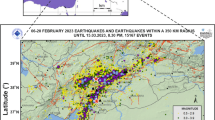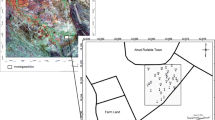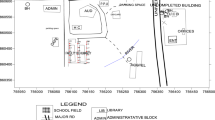Abstract
Seismic features of the site are studied in earthquake prone areas. In these studies, the seismic design parameters of the site are determined based on geological and geotechnical engineering features. In this regard, part of the building regulations (European Standard) is related to site classification. In order to classify the land, the bylaws provide various methods such as mean shear wave velocity up to 30 m depth. In the present study, the values of the dynamic modulus of layers are calculated using conventional relationships based on the values of wave velocities for different depths. In this study, data from 22 boreholes, in which Downhole Seismic surveys were performed, were identified and implemented to identify subsurface layers and to determine the dynamic modulus in the area. The results of these studies in land classification were used to evaluate the site effect based on European Standard. The results show that the area under study is classified in class B according to this standard.







Similar content being viewed by others
Abbreviations
- V p :
-
Compressional wave velocity (m/s)
- V s :
-
Shear wave velocity (m/s)
- G :
-
Shear modulus (stiffness) (GPa)
- E :
-
Young's modulus (GPa)
- K :
-
Bulk modulus (GPa)
- \(\left( {\frac{{V_{p} }}{{V_{s} }}} \right)^{2} = \frac{2 - 2\nu }{{1 - 2\nu }}\) :
-
Square of the wave velocity ratio
- n :
-
Porosity
- ν:
-
Poisson's ratio
- ρ :
-
Density (gr/cm3)
- λ :
-
Lame constant
References
Anbazhagan P, Sitharam TG (2008) Site characterization studies of Bangalore using a geophysical method. In: Geotechnical and geophysical site characterization. Taylor & Francis Group, London
ASTM D7400/D7400M-19 (2019) Standard test methods for downhole seismic testing. ASTM International, West Conshohocken. www.astm.org
Boominathan A (2004) Seismic site characterization for nuclear structures and power plants. J Curr Sci 87–10:1388–1397
Eastwood RL, Castagna JP (1983) Basis for interpretation of Vp/Vs ratios in complex lithologies. In: SPWLA 24th annual logging symposium. Society of petrophysicists and well-log analysts
Eurocode CEN (1998: 2004) 8: Design of structures for earthquake resistance-Part 1: general rules, seismic actions and rules for buildings. EN 1
Hajizadeh F, Mirzaee Nezhad A (2015) Check subsurface layer of Orumiyeh city by using seismic. J Math Technol 6:47–52
Hashemi TS, Salamat A, Mohamadi A (2012) Soil classification using shear wave velocity in Shiraz city based on building codes.
Luna R, Jadi H (2000) Determination of dynamic soil properties using geophysical methods. In: Proceedings of the first international conference on the application of geophysical and NDT methodologies to transportation facilities and infrastructure—geophysics, vol 3. pp 1–15
Pickett GR (1963) Acoustic character logs and their applications in formation evaluation. J Pet Technol 15:659–667
Stumpel H, Kahlar S, Meissner R, Millereit B (1984) The use of seismic shear waves compressional waves for lithological problems of shallow sediments. Geophys Prospect 32:667–675
Tabatabaei SH, Salamat AS, Ghalandasrzadeh A, Riahi MA, Beitollahi A, Talebian M (2010) Preparation of engineering geological maps of Bam city using geophysical and geotechnical approach. J Earthq Eng 14(4):559–577
U.S. EPA (1997) Chapter III: surface geophysical methods. In: Expedited site assessment tools for underground storage tanks: a guide for regulators, EPA 510-B-970001, office of underground storage tanks, United States Environmental Protection Agency
Acknowledgements
The first author greatly appreciates the support of Isfahan Region's Metro Company which enabled the data acquisition. We appreciate the critical reading by arbitration committee and we will be acknowledging our gratitude for enlightening suggestion and insightful comments.
Author information
Authors and Affiliations
Corresponding author
Ethics declarations
Conflict of interest
This article is based on the results of the master. On behalf of all the authors, the author stated that there was no conflict of interest.
Additional information
Publisher's Note
Springer Nature remains neutral with regard to jurisdictional claims in published maps and institutional affiliations.
Rights and permissions
About this article
Cite this article
Chatrayi, H., Hajizadeh, F. & Taghavi, B. Identification of Subsurface Structures and Dynamic Modulus Determination Based on Downhole Seismic Surveys (Case Study). Geotech Geol Eng 39, 5279–5289 (2021). https://doi.org/10.1007/s10706-021-01831-x
Received:
Accepted:
Published:
Issue Date:
DOI: https://doi.org/10.1007/s10706-021-01831-x




